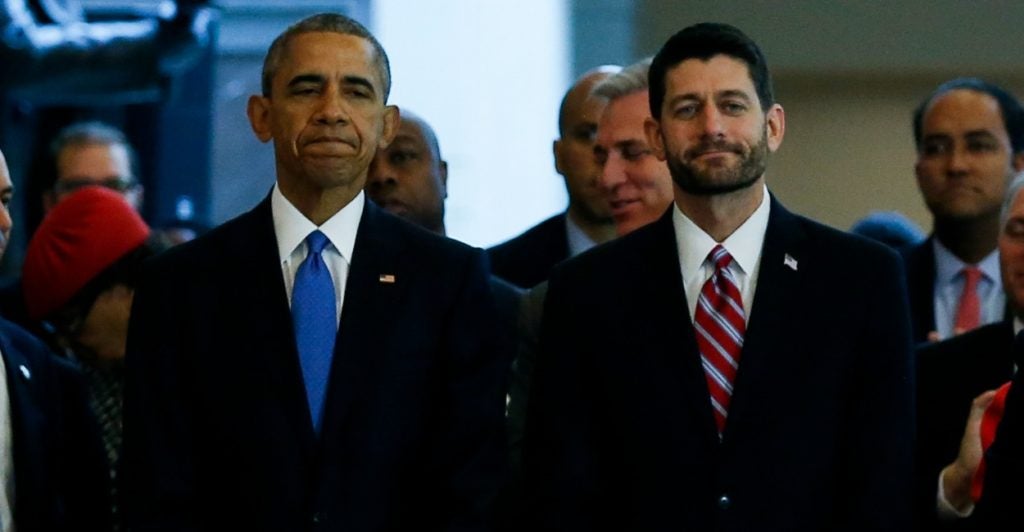After more than six years of Republican pledges to repeal and replace Obamacare, House Speaker Paul Ryan today rolled out a plan to deliver on that promise by abolishing the 2010 law.
The 37-page Republican plan creates a blueprint for rolling back President Barack Obama’s more than 3,000-page marquee health care law. It’s the fifth of six planned installments in the GOP effort to prepare a conservative agenda for the next president and Congress to implement.
“Everyone knows Republicans are against Obamacare. We have got that part down,” Ryan, R-Wis., said on C-SPAN Monday, previewing the plan. “What people need to know is that we have good ideas for what we ought to replace it with.”
The plan meets both of those criteria, said Rep. Kevin Brady, R-Texas, who helped draft the proposal and is chairman of the tax-writing Ways and Means Committee.
“This shows the American public that they don’t have to settle for that horrible bill called Obamacare,” Brady told The Daily Signal, “and that we’re deadly serious about bringing them much more affordable, much more patient-driven health care that doesn’t drive up the budget or increase entitlements.”
Among other provisions, the plan would:
- End the “Cadillac tax” and otherwise equalize tax treatment of insurance plans.
- Modernize Medicare for the elderly and reform Medicaid for the poor.
- Loosen regulations on health savings accounts and encourage other innovations.
- Protect doctors and nurses from being forced to perform abortions against their religious or moral convictions.
Dubbed “A Better Way to Fix Health Care,” the plan starts by abolishing the Affordable Care Act completely—repealing both the employer and individual mandates to purchase health insurance while tearing down the federal health insurance exchanges.
The law, popularly called Obamacare, passed Congress in 2010 without a single Republican vote. Since taking control of the House after the 2010 elections, the GOP has voted several dozen times to abolish Obamacare. In response, Democrats have criticized Republicans for failing to fashion an alternative.
This time it’s different, the Ryan leadership team argues, because they’re finally offering an official replacement package—one that Brady said draws heavily from ideas put forward by the conservative House Freedom Caucus and the much larger Republican Study Committee.
The plan includes many GOP health policy mainstays that Republicans predict will provide more coverage for lower premiums.
To bolster employee-sponsored health insurance, the GOP blueprint repeals the “Cadillac tax,” which levied a penalty on high-cost insurance plans and provides a large share of Obamacare’s funding.
In its place, the Republican plan caps the employer tax exclusion for health insurance. Currently, most Americans receive employer-sponsored insurance on a pretax basis that many conservatives consider an indirect government subsidy.
Capping the exclusion would encourage employers, Republicans argue, to pay employees more in wages rather than in pretax health benefits.
For Americans unable to receive insurance through work or Medicaid and Medicare, the plan creates “a universal advanceable, refundable tax credit.”
Brady described that move as “unlocking” current tax incentives and allowing Americans to choose the health plan they prefer.
The Republican plan also rolls out a grab bag of long-proposed reforms. In particular, it loosens regulations on health savings accounts, allows consumers to cross state lines to buy insurance, and permits groups to form high-risk insurance pools.
To preserve Medicaid, the Republican plan aims to transform it completely. By 2020, the eligibility age for Medicare would rise from 65 to 67, to match that for full Social Security benefits.
The Republican vision, according to the blueprint, would redesign Medicare “into a fully competitive market-based model—known as premium support.” A refurbished version of Ryan’s earlier Medicare plans, the new model allows seniors to spend the premium support on their choice of private plans.
For the Medicaid program for the poor, the Republican plan would kick control back to the states, where “governors and state legislators are closer to patients.” To design their programs, states would take a lump sum from the federal government in the form of either a block grant or a per capita payment.
Criticizing Obamacare’s expansion of Medicaid for “discouraging work,” the blueprint would allow states to develop work requirements for able-bodied adults. To receive Medicaid benefits, states could require able-bodied adults to prove they’re searching for a job or enrolled in a comparable education program.
The Republican overhaul would retain some of Obamacare’s more popular provisions, though.
Insurance companies still couldn’t turn away patients with preexisting conditions, but only if those persons had maintained “continuous coverage.” But if individuals allowed a lapse in coverage, insurers could consider the patient’s medical history in determining higher premiums.
And young people, just like under Obamacare, could stay on their parents’ insurance plan until they turn 26.
The Republican plan would enact conscience provisions such as the Weldon Amendment, protecting doctors and nurses from being forced to perform abortions or other procedures that violate their religious or moral beliefs under the authority of federal, state, or local government. The blueprint also would beef up enforcement of the Hyde Amendment, which prohibits federal taxpayer funding of most abortions.
A blueprint rather than a bill, the Republican plan isn’t designed as a piece of legislation. It does not contain cost estimates or prepackaged legislative proposals. And it’s not supposed to, Brady said.
Instead, the plan provides rough building blocks that individual congressional committees will shape into a final product later.
“We’re not doing one big bill,” Brady told The Daily Signal. “In fact, we’re going to break this up into bite-sized legislation so the American public can understand what changes we’re proposing for them.”
